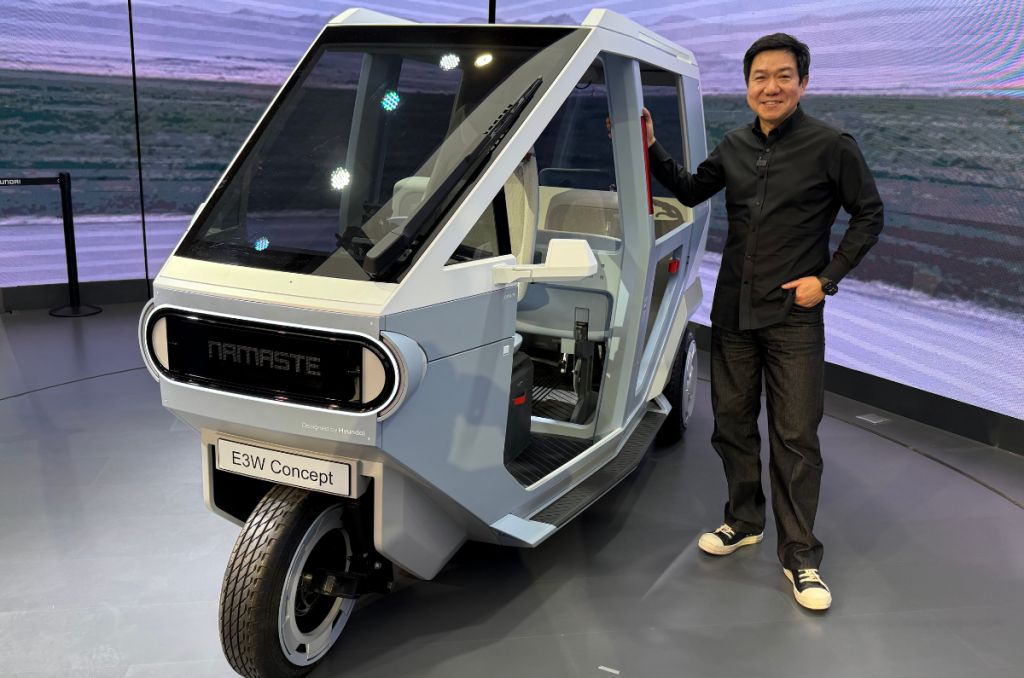
At the Auto Expo 2025, Hyundai revealed its E3W and E4W Micro Mobility concepts developed in collaboration with TVS Motor to address India’s growing need for last-mile connectivity. Hyundai’s executive vice president and global design head, SangYup Lee, shared valuable insights into the development of the E3W, highlighting its “Made-for-India” design that focuses on both practicality and affordability.
Hyundai-TVS collaboration
Lee explained that TVS shared its deep knowledge of the three-wheeler market to help design a vehicle that is both cost-effective and functional. Interestingly, instead of the Hyundai ‘H’ logo, the E3W carries the label “Designed by Hyundai”, hinting that the E3W will be sold under a different brand altogether. The outer front also features a text-displaying screen, a design element reminiscent of those seen on public buses.
E3W concept is bigger, safer, more efficient
The E3W, a three-wheeler EV (as the name suggests), draws design inspiration from India’s ubiquitous rickshaw but offers significant improvements in size and capability. For instance, it features a 280mm longer wheelbase than a regular rickshaw, translating into more interior space. Additionally, the track of the three-wheeler has increased by 20mm, but the wheelbase-to-track ratio is still not ideal.
To counter stability concerns that are inherent with three-wheelers, a sophisticated independent rear suspension has been used. Also giving the E3W the desired stability is the battery pack, which sits below the driver’s seat. Owing to the E3W’s larger dimensions, the engineers could successfully fit a bigger battery and a more powerful motor, enhancing range and performance. However, specific details on battery capacity and motor output remain undisclosed.
Focus on low-cost, simple design
Hyundai’s main goal with the E3W was to create an affordable yet functional vehicle. To keep manufacturing costs in check, the E3W’s body panels were made flat, eliminating the need for complex stamping processes. This design choice led to a simpler, more affordable production method while maintaining a distinctive look. Using flat panels also simplified tooling and reduced expenses. “The customer wants to get more from the product, and we constantly think about the extra value that we could offer,” Lee explained.
“We have not designed something like this before. Instead of developing the vehicle in a fancy design studio, we hit the streets, where it would be used, and spent time with rickshaw users to better understand their daily needs. This was done for two years,” he stated. This hands-on approach allowed Hyundai to incorporate real-world feedback into the design, ensuring that the E3W met the practical requirements of its intended users.
India has world’s fastest EV adoption rate
Lee shared insights into the broader trends shaping the Indian automobile market by noting two things: “The SUV trend in India is rising, and the transition to EVs is faster here than in other markets.” These trends have influenced Hyundai’s approach to designing vehicles that meet the needs of both urban and long-distance travel.
“Dedicated EV platforms offer more flexibility in interior design,” he added while summing up the interview with Autocar India. In vehicles like the Ioniq 5, this freedom results in a more spacious interior, similar to having a “5-room apartment instead of a 3-room one”.
The E3W and E4W concepts represent Hyundai’s commitment to addressing the specific needs of India’s rapidly evolving transportation sector. By focusing on micro-mobility, electric powertrains and affordable design, Hyundai aims to capture a significant share in a market it has never previously entered.
With inputs from Uday Singh
Also, see:
Hyundai and TVS join hands to make micro 3W, 4W electric vehicles in India